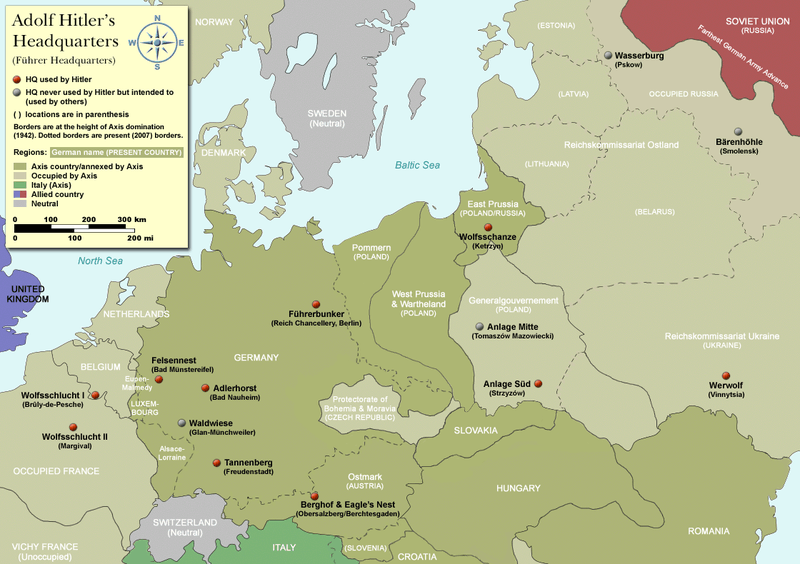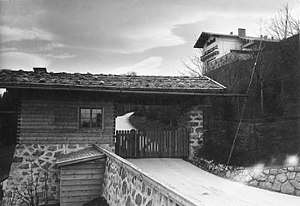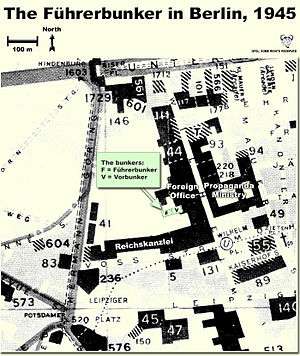Führer Headquarters
The Führer Headquarters (Führerhauptquartiere in German), abbreviated FHQ, were a number of official headquarters used by the Nazi leader Adolf Hitler and various other German commanders and officials throughout Europe during the Second World War.[1] The last one used, the Führerbunker in Berlin, where Hitler committed suicide on 30 April 1945, is the most widely known headquarters.

Other notable headquarters are the Wolfsschanze (Wolf's Lair) in East Prussia, where Claus von Stauffenberg in league with other conspirators attempted to assassinate Hitler on 20 July 1944, and Hitler's private home, the Berghof, at Obersalzberg near Berchtesgaden, where he frequently met with prominent foreign and domestic officials.
Introduction

At the beginning of World War II there were no permanent headquarters constructed for the German supreme leader, the Führer. Hitler visited the frontlines by using either aeroplane or his special train, the Führersonderzug; thus, the Führersonderzug can be considered as the first of his field headquarters. The first permanent installation which became a Führer Headquarters was the Felsennest, which was used by Hitler during the Battle of France in May, 1940. Hitler actually spent very little time in Berlin during the war, and the dwellings he most frequently used were the Berghof and the Wolfsschanze, spending more than 800 days at the latter.
The Führer Headquarters were especially designed to work as command facilities for the Führer, which meant all necessary demands were taken into consideration; communications, conference rooms, safety measures, bunkers, guard facilities etc. were prepared accordingly. Even Berghof and the Obersalzberg complex were modified and extended with considerable defense facilities (bunkers, guard posts etc.). The Wehrmachtbericht, a daily propaganda broadcast covering the war, was also transmitted from the Führer Headquarters.
The Fuhrerhauptquartiere programme used over one million cubic metres of concrete, more than half at Anlage Riese and Wolfsschlucht II. Forced labourers worked for nearly twelve million working days; two-thirds at Anlage Riese, Wolfsschlucht II and Wolfsschanze. [2]
The Führer Headquarters cannot be considered as strict military headquarters; the Wehrmacht had their own, distinctly located in other places, yet often in the vicinity of the FHQs. Nevertheless, since Hitler directly controlled much of the German war effort, the FHQs more than often became de facto military headquarters. In reality, the Führer Headquarters consisted of Adolf Hitler and his entourage, including the Oberkommando der Wehrmacht (OKW) (directly controlled by Hitler), liaison officers and adjutants.
Terminology

Every place Hitler stayed cannot be considered as a Führer Headquarters, and he did not stay at every official FHQ. Furthermore, some sources may not refer to the Berghof and the Führerbunker as official German Führerhauptquartiere at that time in history, but both of them became de facto Führer Headquarters; thus, they are historically often referred to as such.
The Berghof was modified in much the same way as other FHQs,[3] and Hitler had daily conferences on military matters there in the latter part of the war.[3] The "Eagle's Nest", i.e. the Kehlsteinhaus, was rarely used and may not be considered a FHQ as such alone; however, it was associated with the Berghof and part of the Obersalzberg military complex.
The Führerbunker was located about 8.5 metres (28 ft) beneath the garden of the old Reich Chancellery at Wilhelmstraße 77, and 120 metres (390 ft) north of the new Reich Chancellery building at Voßstraße 6 in Berlin.[4] It became a de facto Führer Headquarters during the Battle of Berlin, and ultimately, the last one of his headquarters.[5]
Headquarters locations
There were about 14 known completed Führer Headquarters (of about 20 planned):[6]
| Name | Alternative designations | Location | Build started | Completed | Usage as Führer Headquarters |
|---|---|---|---|---|---|
| Adlerhorst[7] | Mühle (OT) Bauvorhaben Z Lager K Bauvorhaben C |
Bad Nauheim, Germany | 1 Sep 1939 | yes | yes – used by Hitler during the Ardennes offensive; was too late for invasion of Poland, and Hitler told Speer it was too luxurious ... the Führer must show Spartan simplicity[8] |
| Anlage Mitte[7] | Askania Mitte | Tomaszów Mazowiecki, Poland | 1 Dec 1940 | yes | no – only industry |
| Anlage Riese[6] | none | Wałbrzych (Waldenburg), Poland | Oct 1943 | no | no |
| Anlage Süd[7] | Askania Süd | Strzyżów, Poland | 1 Oct 1940 | yes | yes, Hitler met with Mussolini here on 27–28 August 1941[7] |
| Berghof[6] | none | Obersalzberg, Berchtesgaden, Germany | ? | yes | yes – also thought by the Allies to be within an Alpine Fortress "last stand" territory of the Third Reich |
| Bärenhöhle[9] | none | Smolensk, Russia; Platform of Gniesdovo station lengthened for Führersonderzug[10] | 1 Oct 1941 | yes | no – used by Army Group Centre |
| Felsennest[11] | none | Rodert, Bad Münstereifel, Germany | 1940 | yes | yes, used by Hitler during the Battle of France in May, 1940 |
| Führerbunker[12] | none | Berlin, Germany | 1943 | yes | yes, Hitler committed suicide here in 1945 |
| Führersonderzug[1] | (a special train) "Amerika", "Brandenburg" |
various (movable) | 1939? | yes | yes |
| Olga[6] | none | 200 km north of Minsk, Belarus | 1 July 1943 | no | no |
| S III[6] | Wolfsturm, Olga etc. | Ohrdruf, Germany | Autumn 1944 (?) | no | no |
| Siegfried[6] | Hagen[13] | Pullach, Germany (south of Munich) | ? | ? | no |
| Tannenberg[14] | none | Freudenstadt/Kniebis, Germany | 1 Oct 1939 | yes | yes (27 June – 5 July 1940) |
| W3 | Wolfsschlucht III | Saint-Rimay, 15 km west of Vendôme, France | 1 May 1942 | no. | no. Built around a railway tunnel with armoured doors to protect the Führersonderzug, with bunkers for Hitler and for his staff at northeast entrance. Had anti-aircraft emplacements.[15] |
| Waldwiese[9] | none | Glan-Münchweiler, Germany | 1 Oct 1939 | yes | no |
| Wasserburg[9] | none | Pskow (Pleskau), Russia | 1 Nov 1942 | yes | no (assigned to Army Group North) |
| Werwolf[7] | Eichenhain | Vinnytsia, Ukraine | 1 Nov 1941 | yes | yes; on 28 December 1943 Hitler ordered its demolition after failure of Operation Citadel[16] |
| Wolfsschanze[17] | Askania Nord, "Wolf's Lair" | Kętrzyn (Rastenburg), Poland | 1 Dec 1940 | yes | yes, site of the failed 20 July plot on Hitler's life |
| Wolfsschlucht I[18] | Brûly-de-Pesche near Couvin, Belgium | 1 May 1940 | yes | yes. A further bunker planned near the Wolfspalast (formerly the village inn) was not completed.[19] | |
| Wolfsschlucht II[7] | W2, later Zucarello [20] | between villages of Margival and Laffaux, France. The Führerbunker was 2 km up the track from the Margival train station.[21] | 1 Sep 1942 | yes | yes. built around a railway tunnel with armoured doors to protect the Führersonderzug. The compound had six large bunkers; an OKW bunker was adjacent to the Führerbunker, also signals and guest bunkers and anti-aircraft emplacements. [21] |
| Zigeuner[6] | Brunhilde | Thionville, France; used Maginot Line tunnels[10] | 1 Apr 1944 | no | no |
Special train (Führersonderzug)
The Führersonderzug train was named Führersonderzug "Amerika" in 1940, and later Führersonderzug "Brandenburg". The train was used as a headquarters until the Balkans Campaign. Afterwards, the train was not used as Führer Headquarters, however Hitler continued to travel on it throughout the war between Berlin, Berchtesgaden, Munich and other headquarters.
See also
- National Redoubt (the supposed Nazi "Alpenfestung" (Alpine Fortress))
- Nazi architecture
- Vorbunker
- Map over places
References
- Notes
- Raiber, Richard, Guide to Hitler's Headquarters, After The Battle, No. 19, Introduction and p. 1.
- McNab 2014, pp. 37, 48.
- Eberle, Henrik and Uhl, Matthias, The Unknown Hitler, 11th chapter, pp. 199–200.
- Lehrer, Steven, The Reich Chancellery and Führerbunker Complex, p. 123.
- Beevor, Antony, Berlin: The Downfall 1945, p. 357.
- Raiber, Richard, Guide to Hitler's Headquarters, After The Battle, No. 19, p. 2.
- Raiber, Richard, Guide to Hitler's Headquarters, After The Battle, No.19, pp. 48–51.
- McNab 2014, p. 18.
- Der Kommandant Führerhauptquartier Archived 2010-01-25 at the Wayback Machine from Das Bundesarchiv (German, www.bundesarchiv.de)
- McNab 2014, p. 27.
- Raiber, Richard, Guide to Hitler's Headquarters, After The Battle, No. 19, p. 4.
- The Berlin Führerbunker: The Thirteenth Hole, After the Battle Archived 2007-12-26 at the Wayback Machine, No.61 Special Edition (entire)
- McNab 2014, p. 31.
- Raiber, Richard, Guide to Hitler's Headquarters, After The Battle, No. 19, p. 18.
- McNab 2014, p. 43.
- McNab 2014, pp. 59, 60.
- Raiber, Richard, Guide to Hitler's Headquarters, After The Battle, No. 19, p. 28.
- Raiber, Richard, Guide to Hitler's Headquarters, After the Battle, No. 19, p. 10.
- McNab 2014, p. 38.
- McNab 2014, pp. 39-42.
- McNab 2014, pp. 39–42.
- Bibliography
- Beevor, Antony (2002). Berlin – The Downfall 1945. Viking-Penguin Books. ISBN 978-0-670-03041-5.CS1 maint: ref=harv (link)
- Eberle, Henrik; Uhl, Matthias, eds. (2005). The Hitler Book: The Secret Dossier Prepared for Stalin from the Interrogations of Hitler's Personal Aides. New York: Public Affairs. ISBN 978-1-58648-366-1.CS1 maint: ref=harv (link)
- Hansen, Hans-Josef: Felsennest - Das vergessene Führerhauptquartier in der Eifel. Bau, Nutzung, Zerstörung. Aachen 2006, Helios-Verlag, ISBN 3-938208-21-X.
- Kuffner, Alexander: Zeitreiseführer Eifel 1933-45. Helios, Aachen 2007, ISBN 978-3-938208-42-7.
- Lehrer, Steven (2006). The Reich Chancellery and Führerbunker Complex. An Illustrated History of the Seat of the Nazi Regime. Jefferson, NC: McFarland. ISBN 978-0-7864-2393-4.CS1 maint: ref=harv (link)
- McNab, Chris (2014). Hitler's Fortresses: German Fortifications and Defences 1939-45. Oxford; New York: Osprey Publishing. ISBN 978-1-78200-828-6.CS1 maint: ref=harv (link)
- Raiber, Richard, Guide to Hitler's Headquarters, After the Battle, No.19, Special Edition, Battle of Britain International Ltd, 1977, London
- Ramsey, Winston G. (editor) & Posch, Tom (researcher), The Berlin Führerbunker: The Thirteenth Hole, After the Battle, No.61, Special Edition, Battle of Britain International Ltd, 1988, London
- Pierre Rhode/Werner Sünkel: Wolfsschlucht 2 – Autopsie eines Führerhauptquartiers, Verlag Werner Sünkel Geschichte+Technik, Leinburg 1993, ISBN 3-930060-81-7
- Werner Sünkel/Rudolf Rack/Pierre Rhode: Adlerhorst – Autopsie eines Führerhauptquartiers, Verlag Werner Sünkel Geschichte +Technik, Offenhausen 1998, ISBN 3-930060-97-3
- von Loringhoven, Bernd Freytag/d’Alançon, François: Mit Hitler im Bunker. Aufzeichnungen aus dem Führerhauptquartier Juli 1944 – April 1945. Berlin 2005, wjs-Verlag, ISBN 3-937989-14-5.
- Schulz, Alfons: Drei Jahre in der Nachrichtenzentrale des Führerhauptquartiers. Christiana-Verlag, Stein am Rhein. 2. Aufl. 1997. ISBN 3-7171-1028-4.
- Seidler, Franz W./Zeigert, Dieter : Die Führerhauptquartiere. Anlagen und Planungen im Zweiten Weltkrieg. München: Herbig 2000. ISBN 3-7766-2154-0.